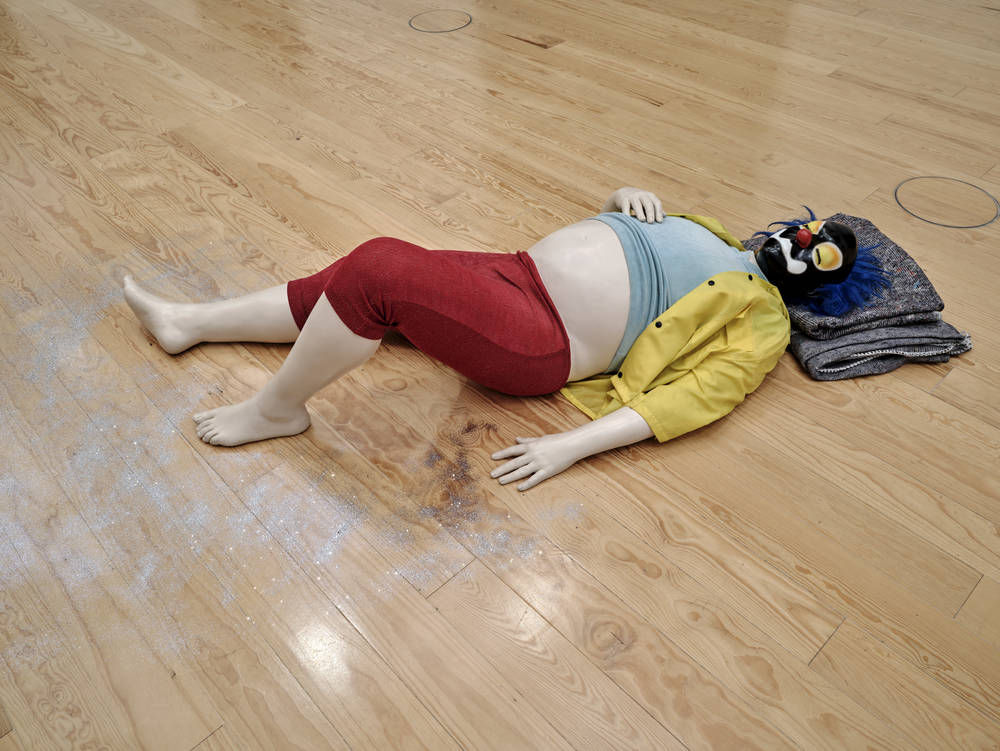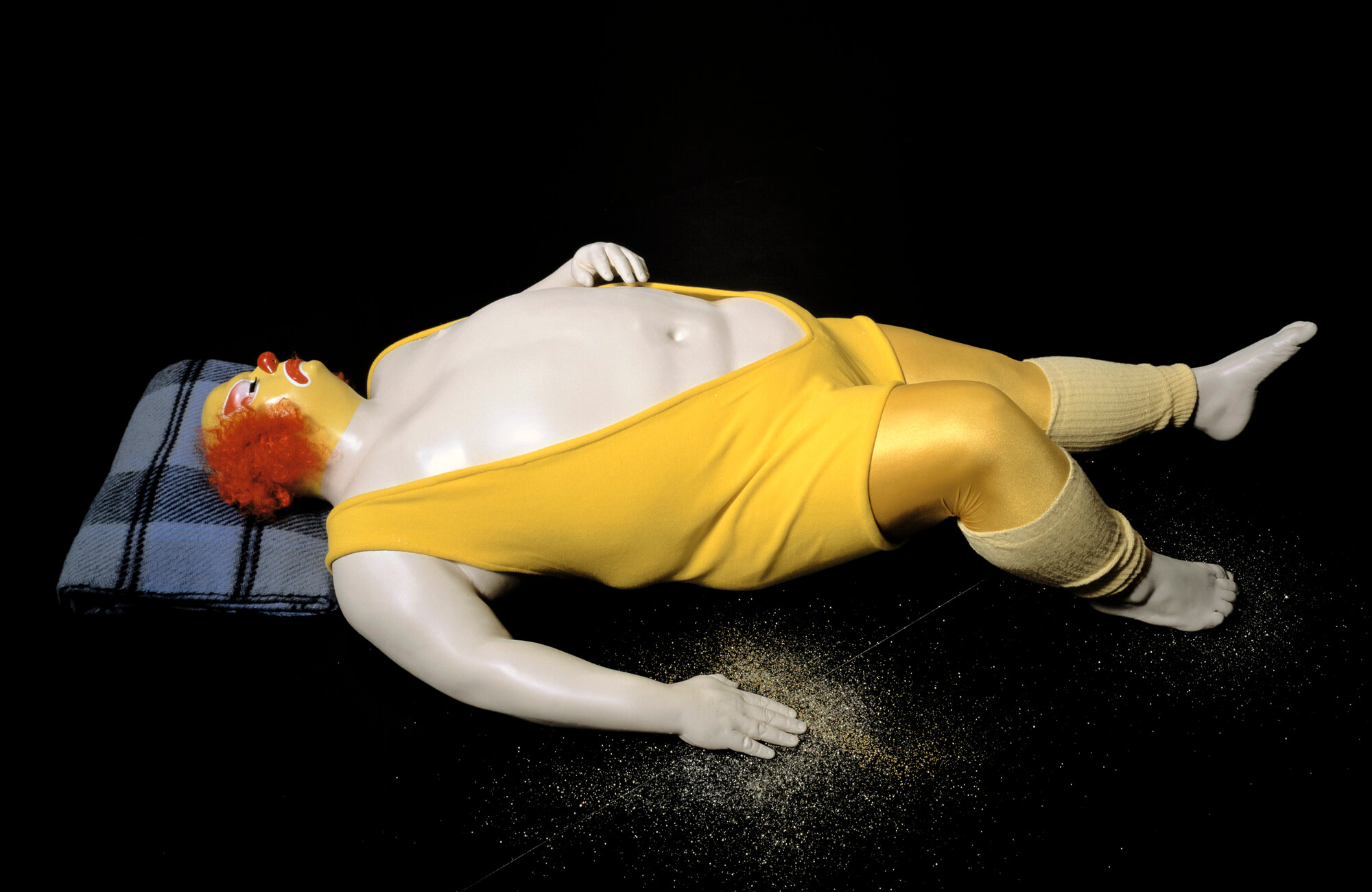Who is it lying over there lost in reverie? In Ugo Rondinone’s work, the figure of the clown is a recurrent theme and represents a colorful, mysterious figure, one far removed from everyday life. Clown expert Elodie Kalb takes a closer look at one of the figures in the exhibition LIFE TIME.
The Clown from “Uncanny Valley”
There it is lying on the ground, a life-sized, disturbing figure – at least, if we grace it with a second look. At first glance, Rondinone’s figure of a clown at Schirn Kunsthalle appears to be reclining on its back in a relaxed pose. Its right leg is stretched out, its left one bent and stood up on the ground. Its arms are positioned exactly the opposite way around – its left one lying stretched out next to its body on the floor and its right one bent and placed on its stomach. Perhaps, in fact, it is lost in thought in this room that is peppered with fragments of the night sky. Or does it appear to belong to another era, to have fallen to Earth from somewhere else?
The figure only starts to appear disturbing when we take a closer look at it – in fact, a great deal doesn’t stack up here. The figure finds itself in an “uncanny valley”, a phenomenon first described by Japanese roboticist Masahiro Mori in 1970, in that gap in acceptance between an all too abstract concept and an all too realistic, human portrayal of artificial figures. We do accept unambiguous shapes, be these matchstick men or true-to-life figures. However, if the boundaries between lifelessness and animation become blurred, we consider the presentation creepy. The same applies to artificial limbs, avatars, wax figures and particularly to dolls. As is the case here.
That “uncanny valley” effect
By means of several subtle shifts that simultaneously provoke the viewer’s curiosity Rondinone’s work underscores that “uncanny valley” effect. Who is it lying there lost in a dream world? We gaze at the various elements looking for clues to the figure’s identity. However, all the different components provide us with are puzzles. For example: Painters normally use a fleece, to protect their customers’ possessions but here the fleece acts as a pillow. To match the stars on the walls the figure on the floor is surrounded by sparkling particles, its legs especially are covered in stardust. The figure’s bare pot belly is disturbing, putting us in mind of children, pregnancy, illness and, of course, the moon. Looking at the situation with the viewing habits of an adult, the figure’s proportions, have become destabilized.

We are familiar with the colors of its open shirt and its pants because of another clown figure – that of Ronald McDonald, that mascot of the fast-food giant that was given the look with which we are familiar today by British/Latvian clown Michael Polakovs back in 1967. However, the figure’s pants and shirt look too small, like children’s clothing. And where on Earth are its shoes?
Fragments from the history of the clown
Something especially unnerving and mysterious about Rondinone’s figure is its head. The latter is completely masked, although it is not clear with what. Here too, many different elements, a large number of different fragments from the history of the clown, appear to have been brought together. We cannot assign anything unequivocally but are instead looking at a whole range of different types of disguises.

Advertising figure Ronald McDonald, photo: George Pearson, CC BY-SA 2.0, via Wikimedia Commons
We see a red latex clown’s nose of the kind that American circus clown Alberto Fratellini wore for the first time sometime around 1920. Since then, it has formed part of the classic accoutrements of “Dummer August” (Stupid Augustus), that clumsy clown who is always failing, confounded by things and by the tasks with which he is confronted. Perhaps we also see stage makeup such as the kind used in the 19th century, the sort that makes the gestures easier to understand from a great distance and in bad lighting, the type that aims at transporting the actor’s facial expression right up to the “back row”. This form of makeup was available in white, for the classic role of the “whiteface” invented around 1800 by British clown Joseph “Joey” Grimaldi. The figure enjoyed great popularity and contributed to the creation of that vain, scene-stealing clown that was the “white clown”. The same makeup also came in black, for the classic role of the “blackface”. To us nowadays the latter practice appears deeply racist. What was once known as “blackfacing” was a well-established practice for white players in the 19th century and represented the only opportunity for people of color to perform at the entertainment shows known as minstrel shows or “blackface minstrelsy” in the United States. A black actor by the name of Bert Williams who was immensely popular around 1900 made his appearances with a “blackface”.
A figur that is allowed to misbehave
However, perhaps it is the case that what we are seeing is not stage makeup but a mask. In the commedia dell’arte, an improvised theater originating in Italy and France, Tristano Martinelli invented the stock character of “Arlecchino” as early as 1584. The character is played with a black half-mask and bushy eyebrows. Since that time, harlequin has been the figure that stands between good and evil and is allowed to misbehave.

George Cruikshank (September 27, 1792 – February 1, 1878), Joseph Grimaldi as clown „Joey“, ca. 1820, Public domain, via Wikimedia Commons

Maurice Sand (30. Juni 1823 – 4. September 1989), Arlechino, 1860 © Maurice Sand, Public domain, via Wikimedia Commons
However, maybe we are also seeing a wrestling mask of the kind used in “lucha libre” wrestling which has been widespread in Mexico since around 1930. From the very beginning of their careers, these wrestlers hide their faces behind colorful masks which they wear until they are defeated in a match, when they are unmasked. Mexican wrestler Rodolfo Guzmán Juerta, known as “El Santo”, was never seen without his mask, even when he was very old. As long as they wear their masks, these wrestlers are considered unbeaten or undefeated. This combination of the elements of “clown” and “wrestler” is also to be found in others of Rondinone’s clown figures in his series “If There Were Anywhere but Desert”.

El Santo, Gobierno CDMX, CC0, via Wikimedia Commons
Nevertheless, however we look at it we cannot find an answer to the question of who is concealed behind the mask, of just who it is lying there. The answer appears to be somewhere beyond the sum of the various elements that we can make out. It remains up in the air, out of the reach of our historical knowledge and even of society-related questions in general. Rondinone’s clown figure defies clear determination of any kind, cheerfully and with the surefootedness of a sleepwalker, having turned away from the world in repose. With its relaxed, receptive appearance, it is receptive to our attempts to interpret it. These attempts lead us to where it is to be found itself in “uncanny valley” – or in the starry skies.

Ugo Rondinone, if there were anywhere but desert. sunday, 2000 © Ugo Rondinone, image via ugorondinone.com









